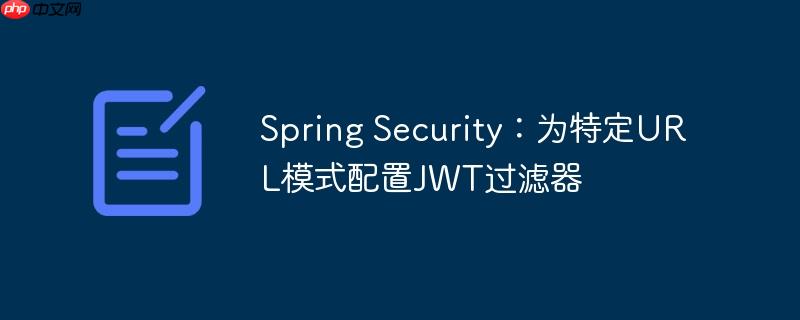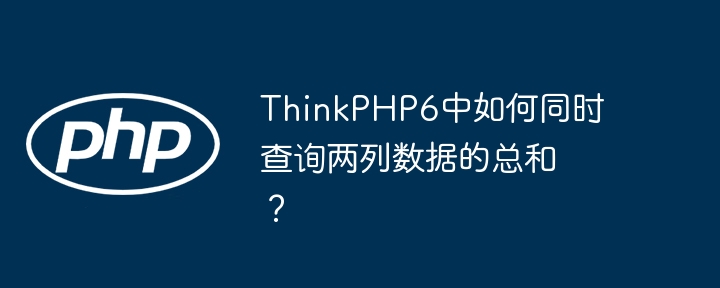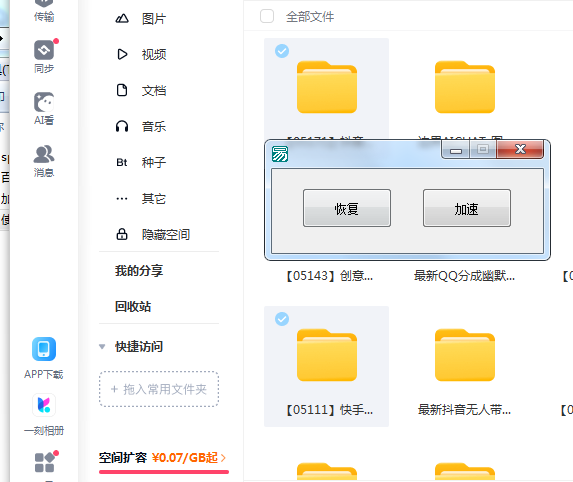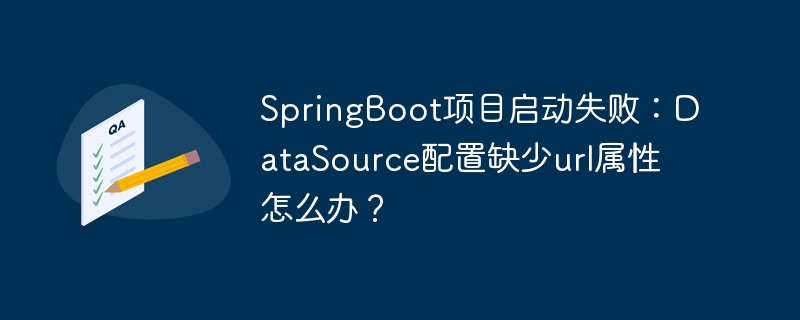
本教程详细讲解如何在spring Boot Security中,精确控制JWT(json Web Token)过滤器的应用范围,使其仅作用于指定的URL模式,而非全局生效。通过继承AbstractAuthenticationProcessingFilter并结合RequestMatcher接口,开发者可以灵活定义哪些请求路径需要JWT认证,从而优化安全策略,避免不必要的性能开销,并增强应用的模块化安全性。文章将提供详细的代码示例和配置步骤,帮助读者实现定制化的安全过滤逻辑。
在spring security中,我们经常需要自定义过滤器来处理特定的认证或授权逻辑,例如jwt认证。然而,默认情况下,通过httpsecurity.addfilterbefore()或addfilterat()添加的过滤器会作用于所有进来的http请求。对于jwt认证而言,通常我们只希望它对受保护的api路径(例如/api/**)生效,而对静态资源、登录页面或公共接口则无需进行jwt验证。本文将介绍如何利用spring security提供的abstractauthenticationprocessingfilter和requestmatcher接口,实现jwt过滤器的精确控制。
挑战:全局过滤器与局部需求
当我们将一个自定义JWT过滤器(例如CustomJwtAuthenticationFilter)通过以下方式添加到安全链中时:
http.addFilterBefore(customJwtAuthenticationFilter, UsernamePasswordAuthenticationFilter.class);
这个customJwtAuthenticationFilter将会在UsernamePasswordAuthenticationFilter之前,对所有进入应用的请求进行处理。这意味着即使是访问/login、/或任何非API路径,该过滤器也会被触发,这不仅可能导致不必要的性能开销,还可能在某些情况下抛出异常(例如,尝试从没有JWT的请求头中解析令牌)。
解决方案:AbstractAuthenticationProcessingFilter与RequestMatcher
Spring Security提供了一个抽象类AbstractAuthenticationProcessingFilter,它专门用于处理基于请求匹配的认证流程。这个类的核心在于其构造函数可以接收一个RequestMatcher对象。当一个请求到达时,AbstractAuthenticationProcessingFilter会首先调用其内部的RequestMatcher的matches()方法。只有当matches()方法返回true时,过滤器才会继续执行其认证逻辑(即调用attemptAuthentication()方法);否则,它会直接跳过认证过程,将请求传递给安全链中的下一个过滤器。
RequestMatcher是一个接口,它定义了如何根据HttpServletRequest来判断一个请求是否匹配特定条件。Spring Security提供了多种RequestMatcher的实现,其中最常用的是:
- AntPathRequestMatcher:基于Ant风格路径模式匹配URL。
- OrRequestMatcher:将多个RequestMatcher组合,只要有一个匹配就返回true。
- AndRequestMatcher:将多个RequestMatcher组合,只有所有都匹配才返回true。
- NegatedRequestMatcher:对另一个RequestMatcher的结果取反。
实现步骤
我们将通过以下步骤实现JWT过滤器的精确控制:
1. 改造 CustomJwtAuthenticationFilter
让你的JWT认证过滤器继承AbstractAuthenticationProcessingFilter,并在构造函数中接收RequestMatcher和AuthenticationManager。
import org.springframework.security.authentication.AuthenticationManager; import org.springframework.security.core.Authentication; import org.springframework.security.core.AuthenticationException; import org.springframework.security.web.authentication.AbstractAuthenticationProcessingFilter; import org.springframework.security.web.util.matcher.RequestMatcher; import javax.servlet.ServletException; import javax.servlet.http.HttpServletRequest; import javax.servlet.http.HttpServletResponse; import java.io.IOException; /** * 自定义JWT认证过滤器,仅对匹配特定RequestMatcher的请求进行处理。 */ public class CustomJwtAuthenticationFilter extends AbstractAuthenticationProcessingFilter { /** * 构造函数。 * @param requiresAuthenticationRequestMatcher 定义哪些请求需要此过滤器处理的RequestMatcher * @param authenticationManager 认证管理器,用于执行认证逻辑 */ public CustomJwtAuthenticationFilter(RequestMatcher requiresAuthenticationRequestMatcher, AuthenticationManager authenticationManager) { super(requiresAuthenticationRequestMatcher); // 将RequestMatcher传递给父类 setAuthenticationManager(authenticationManager); // 设置认证管理器 } /** * 实现JWT认证的核心逻辑。 * 只有当RequestMatcher匹配时,此方法才会被调用。 */ @Override public Authentication attemptAuthentication(HttpServletRequest request, HttpServletResponse response) throws AuthenticationException, IOException, ServletException { // 在这里实现你的JWT解析和认证逻辑 // 例如:从请求头中获取JWT令牌 String authorizationHeader = request.getHeader("Authorization"); if (authorizationHeader == null || !authorizationHeader.startsWith("Bearer ")) { // 如果没有Bearer Token,抛出认证异常,或返回null让后续认证机制处理 throw new AuthenticationException("Missing or invalid JWT token in Authorization header") {}; } String jwtToken = authorizationHeader.substring(7); // 提取JWT字符串 // TODO: 根据你的JWT库和业务逻辑验证jwtToken,并构建一个Authentication对象 // 例如: // JwtAuthenticationToken authenticationToken = new JwtAuthenticationToken(jwtToken); // return getAuthenticationManager().authenticate(authenticationToken); // 委托给AuthenticationManager进行认证 // 示例:此处仅为演示,实际应替换为你的JWT验证逻辑 System.out.println("Processing JWT for path: " + request.getRequestURI()); // 假设成功验证并返回一个Authentication对象 // return new UsernamePasswordAuthenticationToken("user", null, Collections.emptyList()); throw new UnsupportedOperationException("JWT认证逻辑待实现,请替换为实际的令牌验证和用户身份构建。"); } // 可选:重写successfulAuthentication和unsuccessfulAuthentication方法来处理认证成功或失败后的逻辑 // @Override // protected void successfulAuthentication(HttpServletRequest request, HttpServletResponse response, FilterChain chain, Authentication authResult) throws IOException, ServletException { // super.successfulAuthentication(request, response, chain, authResult); // // 认证成功后继续过滤器链 // chain.doFilter(request, response); // } // @Override // protected void unsuccessfulAuthentication(HttpServletRequest request, HttpServletResponse response, AuthenticationException failed) throws IOException, ServletException { // // 认证失败处理,例如返回401 Unauthorized // response.setStatus(HttpServletResponse.SC_UNAUTHORIZED); // response.getWriter().write("Authentication Failed: " + failed.getMessage()); // } }
2. 定义 RequestMatcher
针对“只过滤/api/**路径”的需求,我们可以使用AntPathRequestMatcher。
import org.springframework.security.web.util.matcher.AntPathRequestMatcher; import org.springframework.security.web.util.matcher.RequestMatcher; import org.springframework.security.web.util.matcher.OrRequestMatcher; import java.util.Arrays; import java.util.List; import java.util.stream.Collectors; // 简单匹配单个路径模式 // RequestMatcher apiRequestMatcher = new AntPathRequestMatcher("/api/**"); // 如果需要匹配多个路径模式,可以使用OrRequestMatcher // RequestMatcher multiPathMatcher = new OrRequestMatcher( // new AntPathRequestMatcher("/api/v1/**"), // new AntPathRequestMatcher("/secure/**") // );
3. 配置 Spring Security
在你的安全配置类(通常是继承WebSecurityConfigurerAdapter或使用SecurityFilterChain)中,将改造后的CustomJwtAuthenticationFilter作为Bean注入,并添加到安全链中。
import org.springframework.context.annotation.Bean; import org.springframework.context.annotation.Configuration; import org.springframework.security.authentication.AuthenticationManager; import org.springframework.security.config.annotation.authentication.builders.AuthenticationManagerBuilder; import org.springframework.security.config.annotation.web.builders.HttpSecurity; import org.springframework.security.config.annotation.web.configuration.EnableWebSecurity; import org.springframework.security.config.annotation.web.configuration.WebSecurityConfigurerAdapter; import org.springframework.security.config.http.SessionCreationPolicy; import org.springframework.security.web.authentication.UsernamePasswordAuthenticationFilter; import org.springframework.security.web.util.matcher.AntPathRequestMatcher; import org.springframework.security.web.util.matcher.RequestMatcher; @Configuration @EnableWebSecurity public class SecurityConfig extends WebSecurityConfigurerAdapter { // 假设你有一个JwtAuthenticationEntryPoint处理认证失败的入口点 // @Autowired // private JwtAuthenticationEntryPoint jwtAuthenticationEntryPoint; // 假设你有一个UserDetailsService用于加载用户详情(如果JWT认证需要) // @Autowired // private UserDetailsService userDetailsService; /** * 配置HTTP安全策略。 */ @Override protected void configure(HttpSecurity http) throws Exception { http.csrf().disable() // 禁用CSRF,因为JWT是无状态的 .sessionManagement().sessionCreationPolicy(SessionCreationPolicy.STATELESS) // 设置会话管理为无状态 .and() // .exceptionHandling().authenticationEntryPoint(jwtAuthenticationEntryPoint).and() // 配置认证入口点处理未认证请求 .authorizeRequests() .antMatchers("/api/**").authenticated() // 明确指定 /api/** 路径需要认证 .anyRequest().permitAll() // 其他所有请求都允许访问 .and() // 将我们定制的JWT过滤器添加到UsernamePasswordAuthenticationFilter之前 .addFilterBefore(customJwtAuthenticationFilter(), UsernamePasswordAuthenticationFilter.class); } /** * 将CustomJwtAuthenticationFilter注册为Spring Bean。 * 注意:这里需要捕获AuthenticationManagerBean()抛出的异常。


















